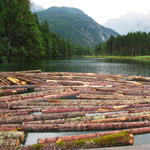
Principles of Sustainability
Chapter 5 - Industrial Approaches to Sustainability
Part 7 - Sustainable Forestry
 The Food and Agriculture Organization (FAO) of the United Nations defines sustainable forest management as the stewardship and use of forests and forest lands in a way, an at a rate, that maintains their biological diversity, productivity, regeneration capacity, vitality and their potential to fulfill, now and in the future, relevant ecological economic and social functions, at local, national and global levels, and that does not cause damage on other ecosystems.
The Food and Agriculture Organization (FAO) of the United Nations defines sustainable forest management as the stewardship and use of forests and forest lands in a way, an at a rate, that maintains their biological diversity, productivity, regeneration capacity, vitality and their potential to fulfill, now and in the future, relevant ecological economic and social functions, at local, national and global levels, and that does not cause damage on other ecosystems.
The relationship of humans to the natural bounty of forests has always been complex, and when this relationship is out of balance or disrupted beyond the adaptive capacity of the ecosystem, key elements of the system can be threatened, sometimes with irreversible consequences. Forests of all types play a critical and complex role in the biogeochemistry of the Earth. They store the energy of the sun in plant carbohydrates and in doing so regulate the atmosphere.
Forests are also zones of production of renewable resources for fiber and fuel. The forest ecosystem supports biodiversity and the subsistence of many indigenous peoples and forestry-dependent community economies. The ecosystem services and natural beauty of forests are of high value in the assessment of the role forests play as foci of the biological richness of the planet. As such they demand our respect and continued study in their management, development, conservation, and preservation.
Keywords
- forestry
- sustainable forestry
- sustainable forest management (SFM)
- ecosystem management (EM)
- sustainable development
- 1992 World Summit, Rio de Janeiro
- intergenerational fairness
- precautionary principle
- risk avoidance
- adaptation
- adaptive forest management
- adaptive management cycle (AMC)
- flexibility
- conventional logging (CL)
- conventional forest management (CFM)
- sustained yield management (SYM)
- sustained timber management (STM)
- sustained yield timber management (SYTM)
- ecosystem approach (EA)
- Convention on Biological Diversity
- certified wood
- Sustainable Forestry Initiative
- Forest Stewardship Council
Reading
-
Sustainable Development and Sustainable Forestry: Analogies, Differences, and the Role of Flexibility. (2010) Hahn, W. A. and Knoke, T. European Journal of Forest Research. 129:5 Pages: 787-801.
- Sustainable Forest Management and the Ecosystem Approach: Two Concepts, One Goal. FAO, 2003
(Photo credit: Michaelaw, 2010)
